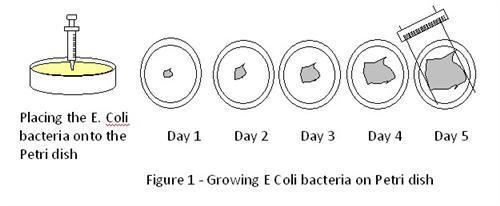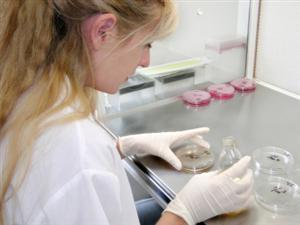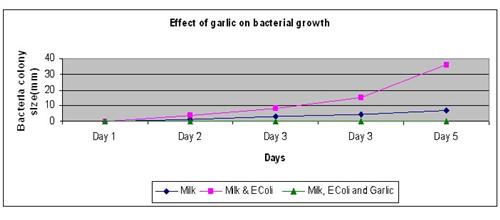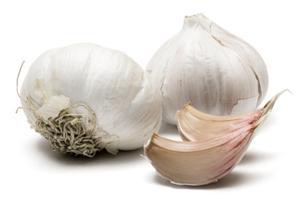| Complexity level: | 5 |
| Project cost ($): | 20 |
| Time required: | 1 day to prepare, 5 days for experiment |
| Material availability: | Easily found |
| Safety concerns: | The bacteria should be destroyed before disposal. Pour some bleach into the petri dishes to kill all the bacteria before disposing them in the trash. |
Hypothesis
Garlic will kill bacteria and prevent its further growth.
Overview
Herbs and spices have traditionally been used in cooking as they add flavor to our food. These herbs and spices have also been known to many cultures for their medicinal properties. The oils that are extracted from these spices and herbs are found to be effective in killing bacteria and viruses.
Garlic is known to have the ability to fight bacteria and viruses. It is known to be affective against a wide range of bacteria and also has the ability to combat the common cold. The antimicrobial substance in garlic is called allicin. Allicin consists of approximately 0.3% - 0.5% of the garlic. To maintain the antibacterial properties of garlic, it must be consumed or applied as raw garlic because cooking will destroy the allicin.
Frequent use of antibiotics causes the microbes to develop resistance against the drugs. Studies have shown that garlic has proven its ability to fight against bacteria that has developed resistance to antibiotics. The use of garlic along with other forms medication has been also known to enhance the effectiveness of these drugs.
Scientific Terms
Materials
The materials required for this experiment:
- 3 agar petri dishes prepared with blood agar
- 300ml milk
- 1 measurement cup (to measure 100ml of milk)
- 5 pieces garlic ground and juice extracted( approximately 5ml)
- 3 test tubes
- 4 syringes
- Escherichia coli (E. Coli) specimen
- 2 tooth picks
- 1 permanent marker pen
Procedure
1. For this experiment, the independent variable is the composition of the test specimen. The dependent variable is the growth of the bacteria colony. This is determined by measuring the size of the growth using a ruler. The constants (control variables) are the room temperature, the amount of sunlight and the ingredients in the petri dish agar.
2. The petri dish prepared with the blood agar must be stored in a refrigerator. Before the start of the experiment, remove the petri dish from the refrigerator to allow it to reach room temperature.
3. Three test specimens are made and labeled as described below:
4. Specimen A - 100 ml of milk is measured using the measuring cup and poured into test tube A. With the marker pen, label this test tube A
5. Specimen B - 100 ml of milk is measured using the measuring cup and poured into test tube B. With the marker pen, label this test tube B. Using a toothpick, add a small amount of E. Coli specimen to test tube B. Shake the test tube to mix the specimen thoroughly.
6. Specimen C - 100 ml of milk is measured using the measuring cup and poured into test tube C. With the marker pen, label this test tube C Using a toothpick, add a small amount of E. Coli specimen to test tube C. Next, add the extracted garlic juice to test tube C. The test tube is shaken to mix the specimen.
7. The specimens in test tubes A, B and C are allowed to incubate for 2 hours.
8. Mark the 3 petri dishes - A, B and C. Remove the lid and using the syringe, extract 10 ml of the sample mixture from test tube A and place it in the center of petri dish A.
9. Use a new syringe to extract a 10 ml sample from test tube B and place it in dish B and repeat for test tube C/dish C.
10. Replace the petri dish lids and store the petri dishes in a cool and shaded place.
11. The diameter of the E. Coli colony is measured everyday for 5 days and recorded in the table below.


Results
The results show that test tube B with the milk and E. Coli specimen had the largest colony of bacterial growth whereas test tube C with milk, the E Coli specimen and garlic extract did not show any signs of bacterial growth. Test tube A showed some small signs of bacterial growth probably due tocontamination during the incubation period.

Use the graph below to plot the results in the above table.

Conclusion
The hypothesis that the presence of garlic will kill bacteria and prevent its growth is proven to be true.
The antimicrobial properties of herbs and spices are useful for medicinal purpose and also for the preservation of food. However it is also true that different spices are effective in providing resistance and protection against different types of microbes.
Also consider
Try repeating the experiment by boiling the garlic before extracting the garlic juice. Observe any differences in your results.
Try to repeat the experiment using onions or cloves instead of garlic.
References
- Infection benefits from garlic - http://home.howstuffworks.com/garlic7.htm
- Antimicrobial effects of spices and herbs - http://www.hi-tm.com/Documents/Spices.html

